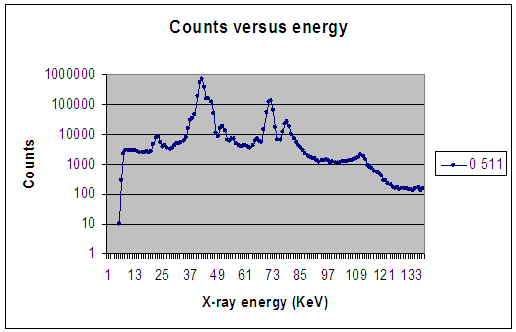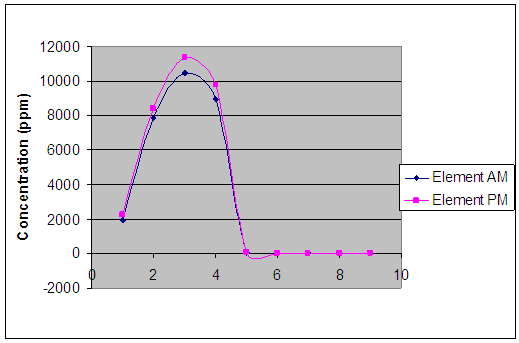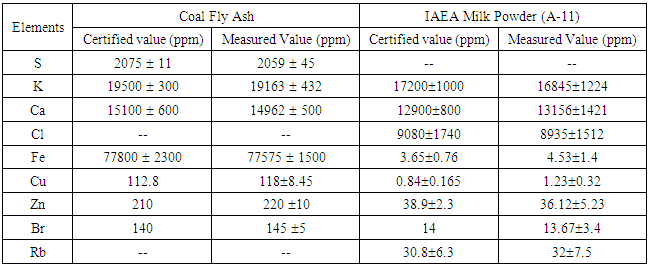-
Paper Information
- Paper Submission
-
Journal Information
- About This Journal
- Editorial Board
- Current Issue
- Archive
- Author Guidelines
- Contact Us
International Journal of Food Science and Nutrition Engineering
p-ISSN: 2166-5168 e-ISSN: 2166-5192
2018; 8(4): 103-106
doi:10.5923/j.food.20180804.03

Effect of Sampling Time and Educational Status of the Lactating Mothers on Human Milk Compositions
R. Khatun1, S. Akter1, M. M. Ahasan2, M. F. Uddin2, M. R. Islam2, H. M. Jamil2, A. N. Monika2, M. A. Rahman2, M. Rahman3, R. P. Das2, R. A. Sharmin2, M. Ohiduzzaman4
1Medical Physics Division, Atomic Energy Centre, Dhaka, Bangladesh
2Institute of Nuclear Medical Physics, AERE, Savar, Dhaka, Bangladesh
3Accelerator Facilities Division, Atomic Energy Centre, Dhaka, Bangladesh
4Department of Physics, Jessore University of Science and Technology, Jessore, Bangladesh
Correspondence to: R. Khatun, Medical Physics Division, Atomic Energy Centre, Dhaka, Bangladesh.
| Email: |  |
Copyright © 2018 The Author(s). Published by Scientific & Academic Publishing.
This work is licensed under the Creative Commons Attribution International License (CC BY).
http://creativecommons.org/licenses/by/4.0/

Breast milk is the best source of nutrition for the newborn infant. There are several factors which may affect the human milk compositions. Among them sampling time and educational status of the lactating mothers is the core interest in this study. In almost all countries, child-death rates are inversely related to the level of maternal education. The study has been conducted to observe whether the human milk varies with sampling time and educational status of the sample providing lactating mothers. The experiments have been done with the 3 MV horizontal type (KN 3000) positive ion Van de Graaff accelerator at the Atomic Energy Center, Dhaka (AECD) by using Ion Beam Analysis (IBA) technique, PIXE. The quantative measurement of trace elements in the present study is as follows: S 2493 ± 530 ppm, Cl 11204 ± 1669 ppm, K 14334 ± 2369 ppm, Ca 10383± 1493 ppm, Fe 60.24 ± 21.61 ppm, Cu 6.23 ± 3.11 ppm, Zn 30.3 ±15.20 ppm, Br 7.54 ± 4.65 ppm and Rb 13.4 ± 7.71 ppm. The concentrations of the elements in the afternoon (PM) samples are obtained higher than those in the morning samples (AM) and concentrations of Zn, Fe and Ca content of breast milk from mothers having educational status Secondary School Certificate (SSC) and above was significantly higher than those of illiterate and primary educated mothers. The measured values of obtained elements are compared with the certified values of Standard Reference and found to be compatible. This article provides an overview of the composition of human milk and sources of its variation pattern with them.
Keywords: Human milk, Nutrients, Toxic elements, PIXE
Cite this paper: R. Khatun, S. Akter, M. M. Ahasan, M. F. Uddin, M. R. Islam, H. M. Jamil, A. N. Monika, M. A. Rahman, M. Rahman, R. P. Das, R. A. Sharmin, M. Ohiduzzaman, Effect of Sampling Time and Educational Status of the Lactating Mothers on Human Milk Compositions, International Journal of Food Science and Nutrition Engineering, Vol. 8 No. 4, 2018, pp. 103-106. doi: 10.5923/j.food.20180804.03.
Article Outline
1. Introduction
- The main pathway of the elements to the human body is the food. Human milk is the most important common food of babies during the early years of their life all over the world. Breast milk is the best source of nutrition for the newborn infant, and exclusive breast feeding is recommended up to 6 months of age [1]. In general, breast milk contains all nutrients required for proper infant development. Even though human milk is the best baby food, a large number of babies die annually as a result of malnutrition and nutritional deficiencies. Recently some major environmental problems are encountered in Bangladesh related to the presence of a number of toxic elements like arsenic and fluoride in ground water and lead in air [2-3]. Physicians in Dhaka Shishu Hospital have found lead in bloods of some babies and Zinc deficiency in arable soil has also become a serious problem [4]. In this situation, the high mortality rate of children in Bangladesh is a great concern and hence search is needed to find out ways and means to reduce the child mortality rate. Women’s education in particular is the most powerful determinant of trends in public health and child mortality. The correlation between parental education and child mortality has been extensively documented. In almost all countries, child-death rates are inversely related to the level of maternal education. The more educated the mother, the healthier she and her child are likely to be. Comparative research focused on 33 countries during the 1980s found that each additional year of maternal education reduced childhood mortality by about 8% [5]. Besides them sampling time is also a parameter which may the concern of nutritional composition of human milk.Several factors, such as dietary intake and genetic background, influence the elemental composition of human milk [6-7]. In this study relationship between human milk concentration, and hence sampling time and educational status of the lactating mothers are considered to show the variation pattern with them and an effort has been made to enlighten whether the elemental concentration of human milk varies with sampling time.
2. Methodology
2.1. Sample Collection and Preparation
- Human milk samples were collected by hand expression from both breasts for about sixty two lactating mothers in different maternity centers of Dhaka during January 2006 to December 2007. The samples were collected twice in a day: one in the morning before breakfast and second in the afternoon after lunch to examine the effect sampling time on the elemental concentration for the same issue. The educational statuses of the corresponding mothers were known by questionnaire to find whether the human milk compositions vary with them.Prior to collection, the nipple areas of the breasts were washed with soap and water, rinsed with distilled water and dried with a tissue. This greatly reduces the possibility of any contamination. Each milk sample was put in specially cleaned plastic bottles and thoroughly mixed together to ensure homogeneity from both breasts. They were immediately frozen and then freeze dried at about -85°C temperature and 133x10-3 mbar pressure [6]. After attaining a constant mass, the dried milk samples were grind to make fine powder and made into pellets and labeled and kept in desiccators. Before grinding a sample the crucible was properly cleaned with acetone every time to avoid contamination.
2.2. Method of Analysis
- The proton induced X-ray emission (PIXE) technique was used to determine the essential and toxic elements in human milk used for this study. The main feature of PIXE method is to ionize an atom to produce characteristic X-ray and to detect them by the Si(Li) detector. The PIXE analysis provides high Z elements such as S, Cl, K, Ca, Fe, Cu, Zn, Ga, Br, Ru, Pb etc. and gives the accurate concentration of the most of the elements present in the samples with high accuracy. In PIXE technique MAESTRO software was used to save the X-ray emission spectra and GUPIX with DAN32 interfacing software [8] was used for analyzing the spectra. The peak of the pulse height spectra gives information of an element and its concentration if it corresponds to the full- energy absorption peak of that element. The peak location is a measure of the photon energy and the peak area represents the number of photons. To identify the element, one has to measure the energy of the peak center accurately and then compare the energy with the PIXE yield database.
3. Results and Discussions
- The mammary gland is capable of regulating concentrations of essential elements such as Cu, Fe and Zn in milk to protect the newborn infant against deficiency and excess of these elements. Our knowledge regarding most element concentrations, especially those of toxic metals, in breast milk, and how they are regulated, interact, or affected by maternal exposure, is however, limited. Despite many important advances in analytical techniques for trace element analyses in biological materials, such analyses are still commonly subject to significant errors due to mass interferences, high risk of contamination, and lack of suitable reference materials. Comparisons of breast milk concentration of elements across studies are hampered by differences in analytical performance, state of lactation and factors related to dietary habits and environmental concentrations. Therefore, literature data are inconsistent for many elements, and it is often not possible to conclude whether the differences are real (representing biological or dietary pattern variability) or artefacts arising from analytical difficulties [9]. This study investigated a wide variety of element concentrations of healthy mother’s breast milk, using a highly sensitive analytical method which enables determination of very low concentrations of elements with high precision.The Minimum Detection Limits (MDL) for this method usually depend on the matrix constituents of the sample. It is, therefore, necessary to keep attention of the MDLs to obtain quality results. Before doing any experiment, it is essential to validate the method accurately and is also important to demonstrate the quality of the data that are being used for decision making. It is necessary to present the data with the confidence that they really reflect the human health and thus environment [10-11] to convince the government or industries to take appropriate steps. However, sometimes it is difficult to find the standards of similar matrix description to the field of respective samples for quality assurance practice. In such cases, validation and good knowledge of the fundamentals of the techniques are not necessarily sufficient to obtain good results; careful attention to details must be needed on the part of the analyst to ensure the quality of results.
3.1. Method of Validation
- The validity of the method has been checked by analysing two standard samples: Standard Reference Material 1633b (Coal Fly Ash) from National Institute of Standard and Technology (NIST) and IAEA Milk Powder (A-11) from IAEA. Measurements were taken several times and the obtained values are presented in Table 1.
|
 | Figure 1. PIXE spectra for standard reference material |
3.2. Effect of Sampling Time
- The results of variation of trace elements in human milk samples with respect to sampling time are given in Figure 2. The samples were collected from the same mothers but at differing time; e.g. in the morning (AM) and in the afternoon (PM). It is clearly evident in Figure 2 that the concentrations of all the elements in the afternoon (PM) samples are higher than those in the morning samples (AM). Feeley et al. [12-13] also reported that elemental contents of the morning samples were significantly lower than those of the afternoon samples. This may be due to whole the night, the lactating mothers don’t take food.
 | Figure 2. Variation of con. of human milk in terms of sampling time |
3.3. Effect of Educational Status of the Mothers
- In almost all countries, child-death rates are inversely related to the level of maternal education. The more educated the mother, the healthier she and her child are likely to be. Nayak et al. [14] found that the socioeconomic factors of maternal education and household prosperity were associated with breast milk composition. Figure 3 shows the impact of mother’s educational status on the concentrations of human milk constituents. Zn, Fe and Ca content in human milk varied significantly for the variation of mother’s educational status. The concentration of Zn, Fe and Ca content of breast milk from mothers with SSC and above educational status was significantly higher than those of illiterate and primary educated mothers. Whereas, the concentrations of S, Cl, K, Cu, Rb and Br do not depend upon the variation of educational status of mothers. Though not significantly, Cu content tended to be higher for higher educational status mother.
 | Figure 3. Effect of mother’s education on human milk composition |
4. Conclusions
- Analysis of breast milk samples showed that the socioeconomic factors of maternal education and sampling time are associated with breast milk composition. Concentration levels of human milk for the elements of Zn, Fe and Ca are found to be significantly higher than those of illiterate and primary educated mothers. Whereas, those of elements S, Cl, K, Cu, Rb and Br do not depend upon the variation of educational status of mothers. The concentrations of all the elements in the afternoon (PM) samples are higher than those in the morning samples (AM). Hence, this finding needs further investigations to give quantitative information about the elemental concentration and to obtain more information about its origin in relation to health consequences for mothers and children.
ACKNOWLEDGEMENTS
- The authors wish to thank all the members of Accelerator Facilities Division for their continuous help during the course of this study. This work was partly financially supported by the Dutch Bangla Bank Foundation Limited, under the DBBL Fellowship Programme is also thankfully acknowledged.
 Abstract
Abstract Reference
Reference Full-Text PDF
Full-Text PDF Full-text HTML
Full-text HTML